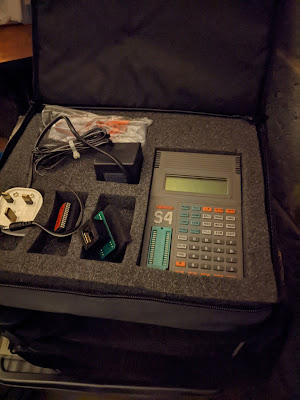...in my retro collection.
It's an Epson PX-8 and it is, quite frankly, completely awesome. It actually came as part of a 'bundle' of great stuff that was once again donated by the most excellent work colleague. The whole bundle is going to take months to really go through but here's a quick overview of what we've now got with a one word indication of whether I've managed to test it or not. It's all been in storage for a VERY long time so not everything will work out of the gate but that's expected.
Epson PX8 (with accessories)
- Epson PX8 computer (working - yay!)
- RAM Disk (not working - boo!)
- TF15 Dual 5 1/4 Floppy Drive Unit (powers up but does not read disks - BDOS ERROR)
- P40 Thermal Printer (not tested yet)
- P80 Printer (not tested yet)
- Oval Automation serial display adaptor (DS80) and interface box (DS8) - (not tested yet but not sure of compatible monitor - it may output RF though)
- Many, many cables...
A selection of pictures:
 |
| The Epson PX8 |
 |
| P40 and P80 Printers |
 |
| TF15 Dual Floppy Drive with Oval Automation Boxes peeking out from underneath |
 |
| TF15 without its cover. It's a mighty beast! |
 |
| TF15 came with original card transport protectors! |
 |
| At least the PX8 works! Here's Wordstar. |
 |
| Many, many cables... |
Psion Organiser (with accessories)
- Psion Organiser model XP (appears to boot OK)
- Psion Organiser model Z64 (appears to boot OK)
- 3 x 16KB Data Paks (not tested)
- 2 x 32KB Data Paks (not tested)
- 1 x 64KB Data Pak (not tested)
- Maths Pack (not tested)
- Finance Pack (not tested)
- Formulator (not tested)
- Data Organiser (not tested)
- Pocket Spreadsheet (not tested)
- Autoscribe Plus (not tested)
- FileMaster (not tested)
- Serial cables (not tested)
 |
| A brace of Psion. |
 |
| I suspect some of this might be quite rare... |
Dataman S4 EEPROM Programmer
- Programmer Unit (not working - some battery damage, batteries removed)
- DIP to PLCC Adaptor (not tested)
- Original Manual & Cables (reads alright :) , cables not tested)
 |
| S4 Programmer - lovely! |
 |
| Ni-Cd Batteries. Not lovely. |
 |
| Leakier than the leaky bucket of Leaky McLeak from the town of Leek. |
Other Stuff
- Original CP/M 2.2 disks in 8 inch floppy format with 5 1/4 inch too and an original manual
- So many CP/M books
- Misc software including some really, really early Microsoft stuff (c.1983)
- Various EEPROMS for the PX8 and other systems
 |
| SupeCalc. Super! (8 inch floppy there) |
 |
| An early Microsoft Thing (Also 8 inch floppy) |
 |
| EEPROM City. |
 |
| So. Much. Stuff. :) |
Palm Computer (with accessories)
Not had a chance to look through the box yet!!
So a veritable smorgasbord of delights (or "more boxes of junk filling the garage" - Mrs Crashed). It really is going to keep me going well into 2022!
Merry Christmas and a Happy New Year to all my regular readers!



































